»To keep bees means to live with bees, to adapt to the laws of their lives and turn this skill of coexistence to one’s advantage.« (Esenko, 2018)
As early as 1770, Empress Maria Theresa appointed Anton Janša from Kranj as the first teacher of beekeeping in the Habsburg monarchy. Today, Slovenian beekeepers are renowned around the world as foremost experts in their field that are well organized and keep bees in a bee-friendly and sustainable way. Their knowledge and skills are highly valued and set an example for beekeepers in other countries. Since the beginning, they have only ever kept Carniolan honey bees (Carniolan gray – Apis mellifera carnica), which have been preserved as a Slovenian autochthonous breed to this day and represent a unique natural and also cultural heritage due to folk art that was motivated by beekeeping in the past.
![]() Slovenians are proud of their beekeeping heritage, especially its specialties, such as the Carniolan honey bee, traditional beehives, beehive panels, apiaries and the transport of bees to honeybee forage. The extensive and diverse tangible and intangible heritage of beekeeping and the use of bee products on Slovenian soil is a testament to the long tradition and incorporation of this rich heritage into everyday life and holidays of individuals, families, social and professional groups. Slovenian beekeepers are people of various ages and professions, most of them are amateurs with a small number of beehives who spend their free time with bees. Beekeeping teaches a person responsibility, perseverance, modesty, hard work, love of nature and homeland. Beekeeping is not only about the production of honey, it is also a way of life for more than 10,000 Slovenes.
Slovenians are proud of their beekeeping heritage, especially its specialties, such as the Carniolan honey bee, traditional beehives, beehive panels, apiaries and the transport of bees to honeybee forage. The extensive and diverse tangible and intangible heritage of beekeeping and the use of bee products on Slovenian soil is a testament to the long tradition and incorporation of this rich heritage into everyday life and holidays of individuals, families, social and professional groups. Slovenian beekeepers are people of various ages and professions, most of them are amateurs with a small number of beehives who spend their free time with bees. Beekeeping teaches a person responsibility, perseverance, modesty, hard work, love of nature and homeland. Beekeeping is not only about the production of honey, it is also a way of life for more than 10,000 Slovenes.
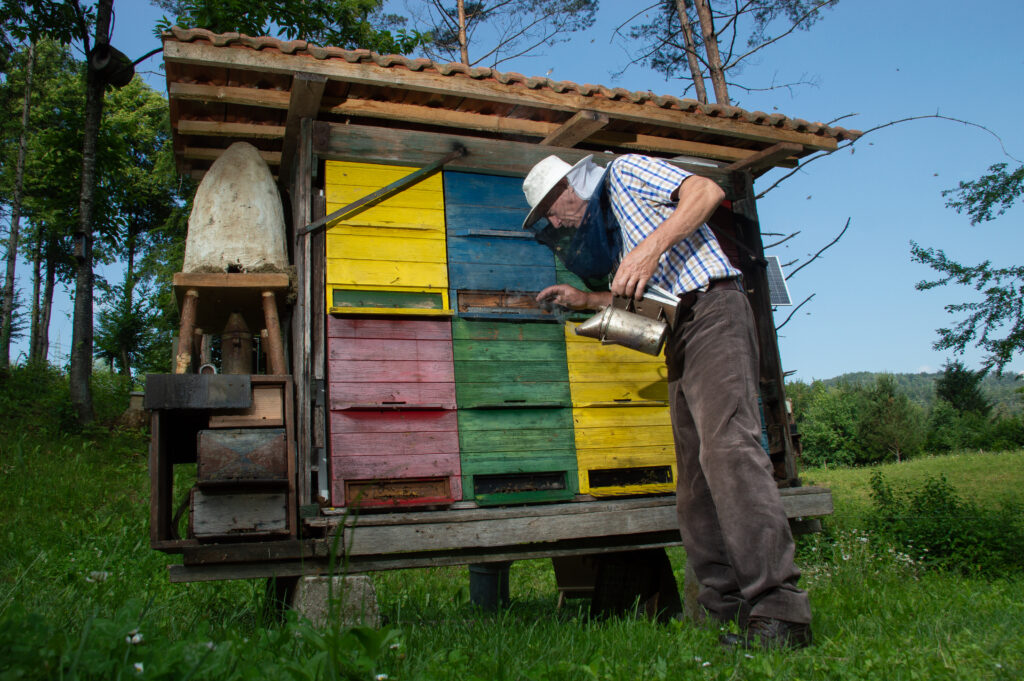
You would be hard-pressed to find a country in the world that is as closely connected with beekeeping as Slovenia. In our lands, beekeeping developed more noticeably in the 18th century, when friendlier tax reforms and measures brought about progress. Especially in the time of Maria Theresa, the rise of beekeeping began on our soil and elsewhere in Europe.
Today, beekeeping in Slovenia is an important agricultural industry, not only because of bee products, but also because bees are indispensable as pollinators of cultivated plants, especially fruit trees and various crops for human and animal sustenance. If we can say that bees haven’t changed that much since people started to keep them, then we can’t say the same for their environment. In recent decades, bees have been confronted with completely new factors that adversely affect them. Consequently, this demands more care for their existence, as harmful factors reduce the resistance of bees, which makes them more susceptible to diseases, pests and the like. It is exactly this new situation that requires new knowledge from the beekeeper, a new way of beekeeping which requires the beekeeper to constantly monitor the health of bees as well as mandatory preventive treatment. A good beekeeper must know the development, needs and directions of development of bee colonies. He or she must not destroy their order of life, but facilitate their development in the direction he or she wants with each task.
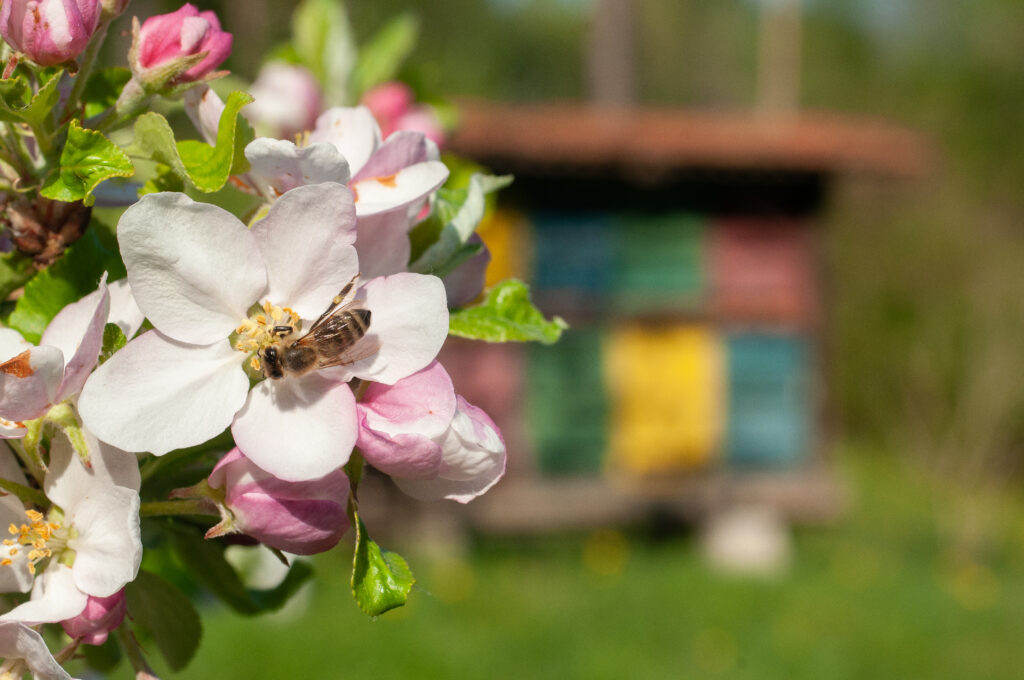
- Notable Slovenian beekeepers in the past
The territory and history of Slovenia have been marked by great beekeeping names, including world-renowned beekeepers. Some have become part of history with their work and their findings and teachings are still used as a beekeeping guide to this day. Beekeeping began to flourish in the 18th century, especially in Carinthia and the northwestern part of Carniola. Successful beekeeping has always been based on a good knowledge of bees and imaginative beekeeping techniques, which were influenced by grazing conditions and also our very own Carniolan honey bee with its excellent characteristics. Beekeeping knowledge was being spread by exceptional men indeed, some of them lifting the shroud of ignorance from the life of bees, others introducing the Carniolan gray to the world by selling bee colonies, swarms and queens, while renowned writers shared their rich beekeeping knowledge with books and articles in agricultural and fine literature. They impressed the crowds and gave beekeeping value. Among them were also several priests who wanted to help farmers by teaching smart beekeeping.
Peter Pavel Glavar (1721 – 1784) devoted his whole life to beekeeping and agriculture, he was a large-scale beekeeper who at the peak of his beekeeping activity kept about 500 beehives. He founded the first beekeeping school in Komenda and later at Lanšprež in the Lower Carniola region. He translated Janša’s Discourse on the Swarming of Bees into Slovene and supplemented it with his experiences and findings. Also notable is his report titled Response to the proposal to improve beekeeping in imperial hereditary lands, where he describes the method of beekeeping in Slovenia, beekeeping conditions, beehives with hive boxes, how to create shaken swarms, the method of breeding queen bees and breeding queen bees outside the hive, bee diseases, transporting bees to honey pasture, etc.
Anton Janša (1734 – 1773) was engaged in beekeeping from an early age. He is considered one of the greatest individuals in the history of beekeeping. In 1770 he became the first teacher of beekeeping at the newly established beekeeping school in Vienna. He was an excellent theorist and practitioner of beekeeping. He wrote two important works the Discourse on the Swarming of Bees (1771) and the Comprehensive Science of Beekeeping (1775), in which he revealed secrets from the life of bees. His work was a resounding success, receiving praise and recognition everywhere. After his death, Empress Maria Theresa even issued a decree obliging all beekeeping teachers to teach only according to the tried and tested methods of Anton Janša.
At Slovenia’s initiative, his birthday, 20 May, was declared World Bee Day by the UN.
Joannes Antonius Scopoli (1723 – 1788) worked as a mine doctor in Idrija between 1754 and 1769. In 1770, his Discourse on Bees was published, in which he describes beekeeping in Carniola. In his famous work the Entomologia carniolica or Entomology in Carniola in 1763, he was the first to argue that the queen bee is fertilized by drones outside the hive.
- Carniolan honey bee
»But there is one hard-working and strong bee, such is the Carniolan honey bee.« (Dr Filip Rothschütz, 1857)
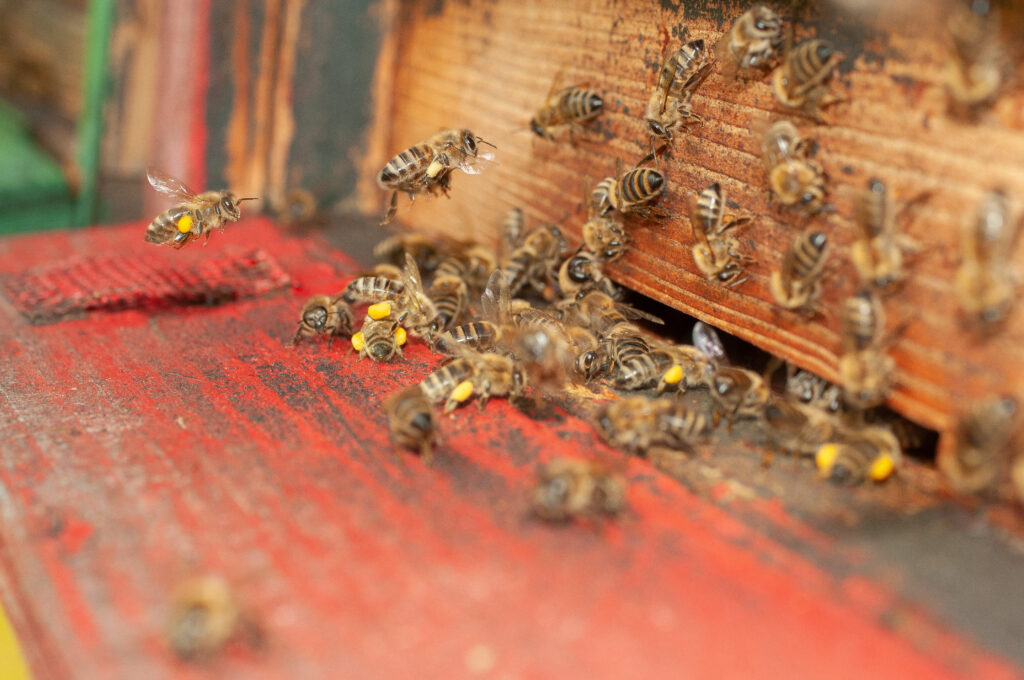
Dr Filip Rothschütz first described the Carniolan honey bee in 1857, which is a Slovenian autochthonous honeybee race. Its ccientific name Apis mellifera carnica was established in 1879 in the work of the German biologist August Pollman.
The Carniolan honey bee lives in the wider area of south-eastern and central Europe, while Slovenia is considered its homeland for historical reasons. It is also found in Austrian regions of Carinthia and Styria, in Hungary, Romania, Bulgaria, Croatia, Serbia, Bosnia and Herzegovina, Montenegro, part of Macedonia and has been artificially introduced to Germany and many other places. The Carniolan honey bee is the second most widespread honeybee race in the world after the Italian honey bee.
In Slovenia, beekeeping is allowed only with the autochthonous Carniolan honey bee, which has exceptional characteristics. It is calm, hard-working, has a long life, never misses its beehive, winters well, consumes little food, multiplies quickly in the spring, is a good honeycomb builder, makes excellent use of abundant foragings, especially in forests, has a well-developed cleaning instinct, so it is less susceptible to disease, has great orientation and likes to swarm. Throughout its long history, the Carniolan honey bee has developed typical morphological and ethological characteristics that distinguish it from other races. Slovenians are the only ones who provide its original genetic material, take care of its genetic purity and maintain its characteristic calmness.
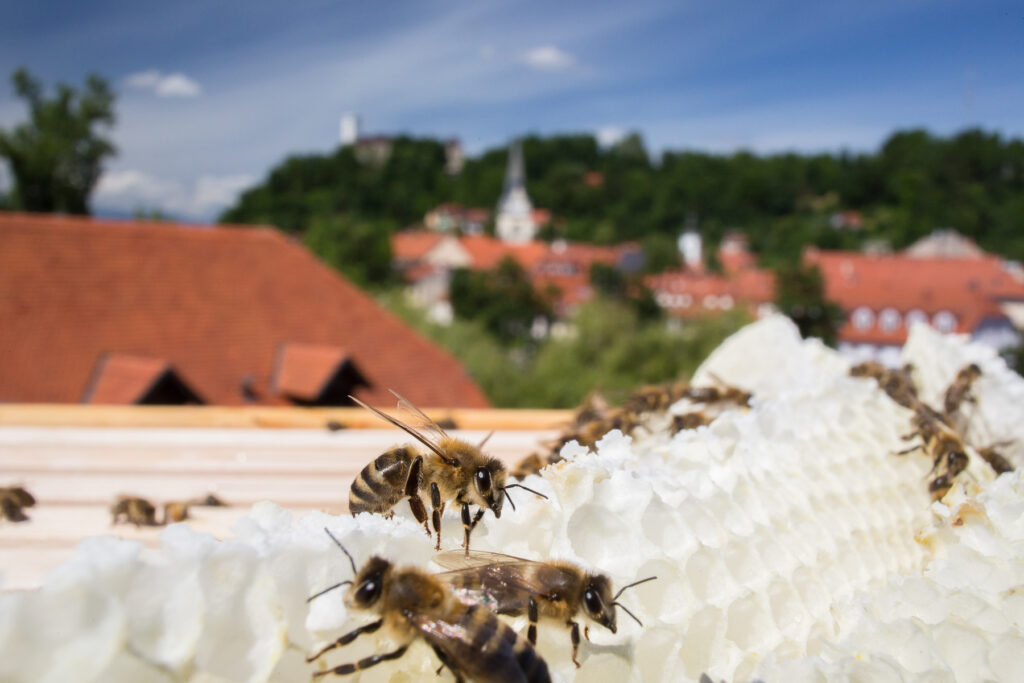
The Carniolan honey bee tries to make good use of all natural food sources with its adaptability, and the development cycle of the bee colony is closely adapted to foraging conditions. The Carniolan honey bee winters in small colonies. The queen bee usually does not lay eggs from October to the end of January, as the first brood is expected in early February. This is followed by a rapid spring expansion of the bee colony and preparation for the first major foraging, which usually happens in late April and early May. With its dance, the Carniolan honey bee describes the direction and distance to the foraging source much more accurately than other bees. When one foraging ends, it begins to explore other areas more intensively with the goal of finding new foraging areas. It also tolerates low temperatures in winter, sometimes below -30 degrees Celsius.
The Carniolan honey bee was once a wild bee, but today its existence depends on humans. The beekeeper must provide them with sustenance, take care of their health and protect them from pests. The main threat to bees are parasitic varroa mites (Varroa destructor), which appeared after 1980. They will destroy the bee colony if the beekeeper does not find a way to deal with them. In areas with intensive agriculture, bees are also threatened by various plant protection products. Climate change is also problematic, especially dry and rainy summers, when natural food resources are in short supply.
- Beehive panels
In the second half of the 18th century, when small elongated beehives made of boards, called “kranjiči”, predominated in Slovenia, a special art of painting beehive panels developed. Painted beehive panels are oil-painted wooden front boards on kranjiči beehives, stacked in the beehives of wealthier farmers, rural lords and parishes. The beekeepers could distinguish the beehives and their owners by the paintings and the beehives were symbolically handed over to the painted saints for protection and good fortune.
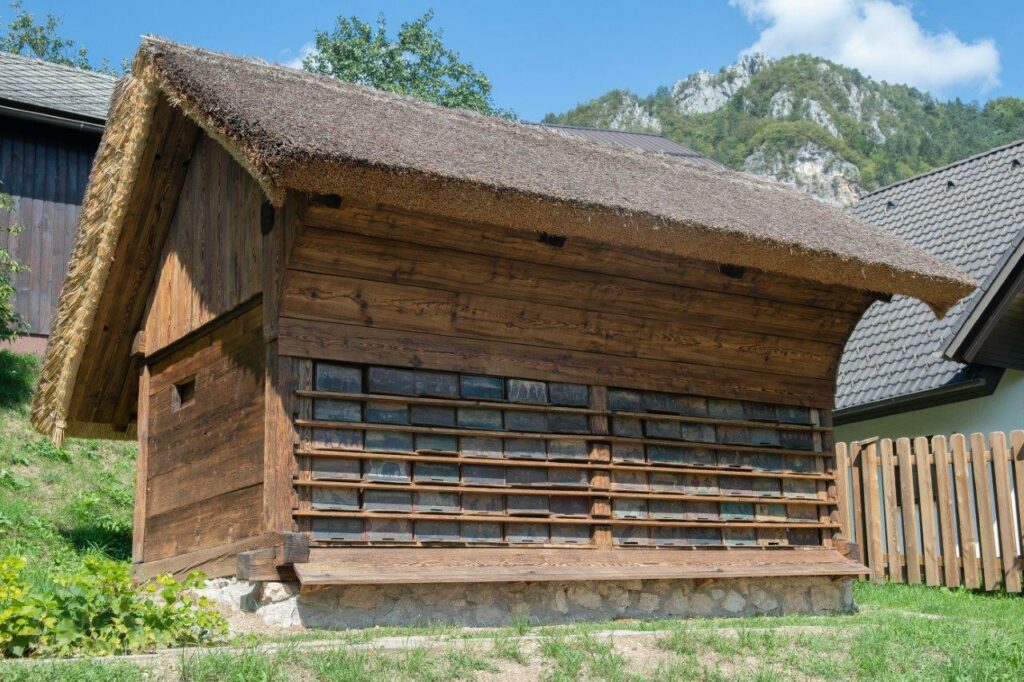
From the middle of the 18th century until the First World War, more than 50,000 beehive panels were painted. They are an original genre of folk art that was not common in non-Slovenian lands. They were mostly painted by simple self-taught painters who took motifs from icons, pictorial bibles from Germany, graphics as well as newspaper and book illustrations and were often inspired by their own imagination. Folk painters painted and depicted historical events, legends, religious and humorous motifs, and events of everyday peasant life in their own way on beehive panels. More than 600 motifs were used in these paintings, a good half of which contained religious messages.
- AŽ beehives
The beekeeper must provide his bees with good living conditions, observe them carefully and know their life hidden behind the walls of the beehive. The beehive must first provide enough space for the well-being and development of the bees and enable the beekeeper to use the acquired knowledge and skills in a way that will result in a good yield with as little cost and effort as possible. Each beehive system has its advantages and disadvantages. The bees in it depend primarily on the beekeeper’s knowledge and mastery of technology.
At the turn of the 20th century, several imported modern beehives and their domestic versions were in use in Slovenia. Since none of them satisfied the needs of Slovenian beekeepers, however, the most resounding innovation was provided by the pioneer of the new beekeeping era, Anton Žnideršič (1874-1947), a large-scale beekeeper from Ilirska Bistrica. He designed a beehive that enables the Carniolan honey bee the best possible development in our environment, ensures a higher yield of honey and wax and makes it easier for beekeepers to work in the apiary and transport bees to foraging.
The beehive, which has established itself under the name Alberti-Žnideršič beehive, as Anton Žnideršič was inspired by the German beekeeper Adolf Alberti when designing this beehive, is operated from behind and is part of the stack. In this beehive, the combs are placed longitudinally in the direction of the bees’ flight. Combs can be moved like pages in a book. This leaf hive quickly became popular among Slovenian beekeepers and is still used by more than 90 percent of beekeepers. The home of the Carniolan honey bee is thus usually the AŽ beehive.
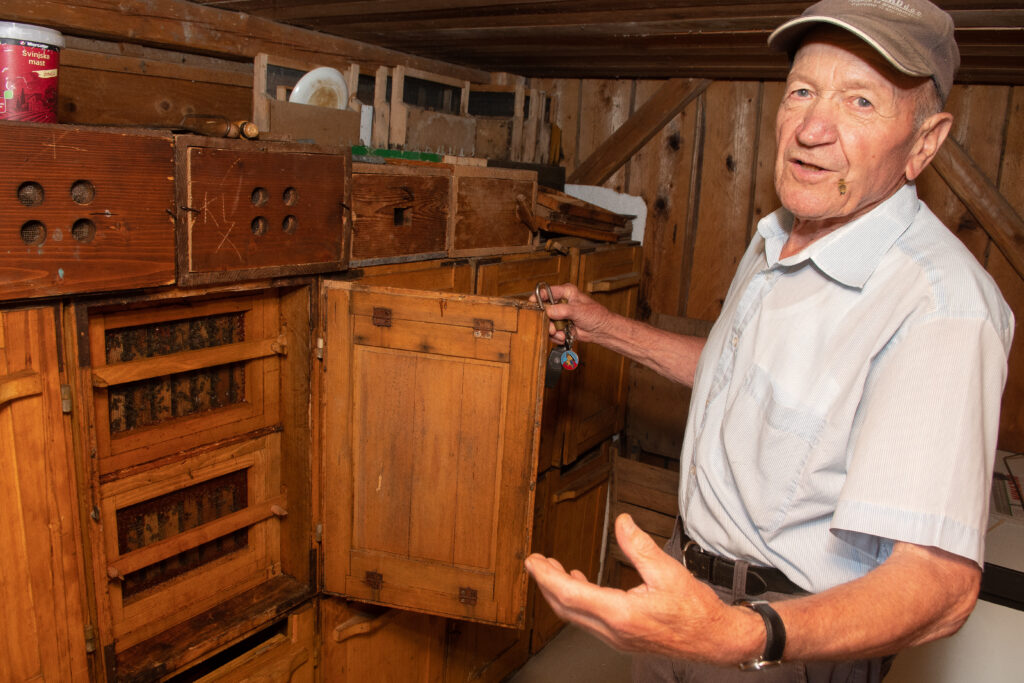
AŽ beehive is a Slovenian trademark of inestimable value and thus an important component of Slovenian cultural heritage. Standard dimensions have been set for this beehive, which are the result of many years of testing and research. Today we know it in various designs, both by the number of combs and by the number of floors. It usually consists of 10 combs. Žnideršič himself and many Slovenian beekeepers constantly changed and supplemented it. AŽ beehive has spread to other countries, even to America.
- 20 May – World Bee Day
At the suggestion of ČZS, Slovenia took the initiative in 2014 to make May the 20th World Bee Day. As part of the initiative, Ministry of Agriculture, Forestry and Food representatives travelled around the world with the Bee World pavilion, actively promoting and raising awareness about the initiative and other support projects. In doing so, they held numerous bilateral meetings with representatives of other countries and international organizations and organized professional events. The response of the Slovenian and international public was positive, the initiative was supported by top Slovenian politicians, the world beekeeping organization Apimondia, the United Nations Food and Agriculture Organization (FAO), the European Union and many other organizations.
After more than three years of efforts, a resolution to declare World Bee Day was adopted on 17 November 2017 by the UN Economic and Financial Committee. The resolution was then unanimously approved by the UN General Assembly in New York on 20 December 2017, declaring May the 20th World Bee Day.
It was supported by all UN countries, with 115 countries co-sponsoring it, including some of the largest countries, such as the United States, Canada, China, Russia, India, Brazil, Argentina, Australia and all European Union countries.
World Bee Day aims to raise awareness among the world public about the importance of conserving bees and other pollinators, which are increasingly endangered and now more than ever in need of conditions that will enable them to survive. We should be aware that in addition to bee products, which are considered quality food, the greatest contribution of bees and other pollinators is the pollination of almost three quarters of all plants. As much as a third of the world’s food production depends on pollinators.
The date of May 20 is related to the birthday of the first teacher of modern beekeeping and Slovenian beekeeper Anton Janša. At the same time, May is a month of proliferation of bees and nature in the northern hemisphere, and in the southern hemisphere a time when bee products and the fruits of bee pollination are harvested as ecosystem services.
Every year on World Bee Day, numerous celebrations, conferences, commemorations and other events take place in Slovenia and around the world, raising public awareness of the importance of preserving bees, pollinators and biodiversity. At the same time, the celebrations are also an opportunity to promote beekeepers, bee products, beekeeping cultural heritage and beekeeping in general. Every year, an international celebration of World Bee Day is organized worldwide by the FAO and the host country. The first one took place on 20 May 2018 in Slovenia, more precisely in Žirovnica, which is the birthplace of Anton Janša.
More at > https://worldbeeday.org/si/